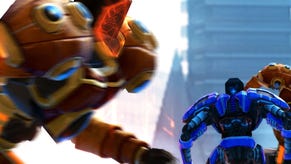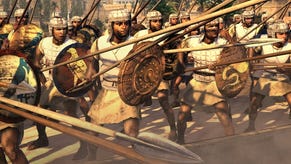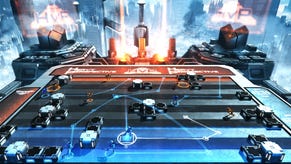How Frozen Endzone restores and reinvents a forgotten genre
Back to the future sports.
Frozen Endzone's about hand-crafted strategies pieced together in long thoughtful minutes and then unpicked in scrappy, tense seconds; it's about territorial scraps that reward the deep thinker who possesses vision. It's hardly strange that Mode 7's follow-up to Frozen Synapse leans so heavily on the thumping strategy of American football, then - it'd be frankly odd if it turned out to be anything else.
After the minimalistic death corridors of Synapse, Endzone's more athletic get-up - complete with primary coloured players and wrapped in gloriously overstated pageantry - can be hard to swallow, at least to anyone like myself who associates the sport of gridiron with thundering hunks of thoughtless meat colliding with one another in a world of obfuscation. Anyone with an education, though, will tell you that American football's a fine and thoughtful sport. Someone like, say, Frozen Endzone's creator Ian Hardingham.
"The thing I love about American football is you have all these great players out on the field but then you have the coaches and the ridiculous preparation that goes into each individual play," he enthuses. "When you have a 45-minute long soccer half you can have all the tactics in the world but a lot of it comes down to reacting. But when each American football play is only something like 10 seconds long, such a large percentage of it is down to exactly where they move their troops to a certain extent."
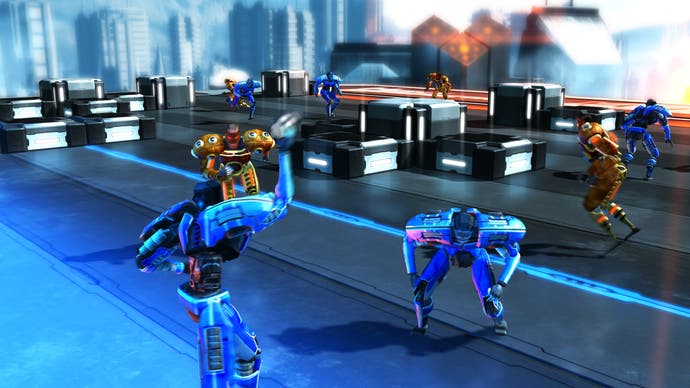
It sounds like there's a game in there somewhere, and one that's very familiar to players of Mode 7's earlier success. At heart Frozen Endzone's very similar in heart to Synapse: you've a static view of the field and you're free to position players, planning runs that can be previewed by tapping the space bar before you fully commit to them, watching them unfurl or collapse in small five second bites. And, as with Synapse, different maps demand different tactics - some provide little warrens you can funnel attacking players with, while others are more open requiring you to pass the ball more freely between the team.
It all benefits from an interface that's as clean as the game is smart, and from a rule-set that's largely self-explanatory. Playing in defence it's about blocking runs and orchestrating collisions between rival players. In attack, getting the ball down one end of the field gets the maximum yield, though there are other scoring zones strategically placed, plus the opportunity to gain multipliers by running through certain pads before reaching the endzone. If you're thinking it sounds like a quick-witted compatriot of future sport titles like Speedball, you're not alone - Mode 7's happy to court the comparison, and a single player mode that will introduce class roles and skill points takes the likeness on even further.
But really it's when Frozen Endzone's at its most pared back that it really shines, and you shouldn't conflate its passion for gridiron with a shared love of bloated statistics and technicalities. This is as slick and simple as a playground game of bulldog, only with the capacity for some serious depth. And robots. "Perversely a lot of people here are having the reaction that American sports are complicated, so they assume this game is complicated - but that's the opposite of everything I've designed," says Hardingham.
What Hardingham's designed is so ingenious it's sort of a wonder that it's not more commonplace. Turning a sport - even a far-fetched, half-imagined one such as Frozen Endzone's - into a turn-based strategy is something of a masterstroke, allowing armchair tacticians to conduct entire teams without having to resort to awkward fingers and thumbs. It's not the first game to do it - Hardingham points out a debt to a mode within Chaos League, even if he admits that Cyanide's own effort wasn't actually all that - but it's quite possibly going to be the best.
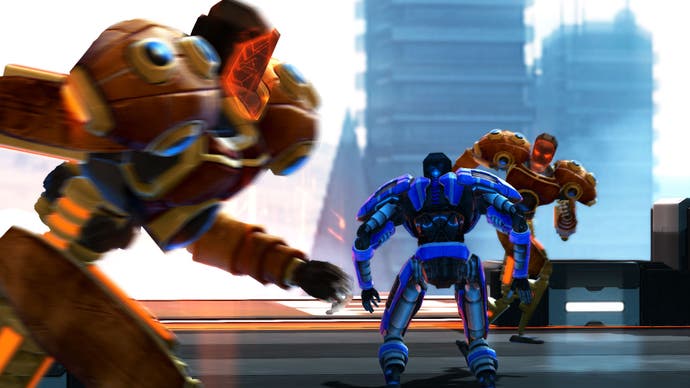
It's sport filtered not only through a video game, but through a particularly smart one. Listen to Hardingham talk about the appeal of Frozen Endzone and you begin to realise that sport itself can be more intellectually stimulating than many of us may care to admit. "You're both seeing the same field, and what's amazing is that it's almost a shared mathematical exercise," he says of the game, though he could just as easily be talking about the knotted plays on an American football field. "It's like in poker, everyone who's a good poker player knows the exact odds once you've got a certain hand. And in this, you've got to work out how likely your opponent is to do something."
Frozen Endzone's got the potential for some cerebral scraps made brutally physical by its warring bots, then, and even if my resolutely non-tactical mind struggled at first to get to grips with its mechanics it's one of those great games that's a delight to see played well. A series of plays recorded by Mode 7's Paul Taylor show some devilish tactics, full of counters being countered and improbable runs being perfectly executed. It's the kind of thing that could go down well on the eSports stage, even if that wasn't part of Frozen Endzone's original plan.
"Six months ago I would have said I wouldn't have expected it would work as an eSports," says Hardingham. "But watching other people viewing the game being played, the way they were talking about it and enjoying it makes me think it could really work." It really could, but no matter where Frozen Endzone ends up, it's sure to be something worth cherishing: a smart sports game, and another brilliant slice of strategy from Mode 7.




